Alte Pinakothek, Munich
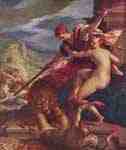
Victory of truth, Hans von Aachen
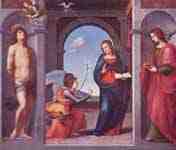
Annunciation to Mary, Mariotto Albertinelli

Battle of Issus, Albrecht Altdorfer

Forest Landscape with St. Georges Dragon fight, Albrecht Altdorfer

Danube landscape near Regensburg with the Scheuchen mountain, Albrecht Altdorfer
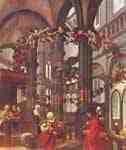
Birth of Mary, Albrecht Altdorfer

Mary in Glory, Albrecht Altdorfer

Portrait of Christoph Fugger, Christoph Amberger
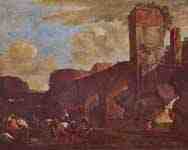
Wide river with arched bridge, Jan Asselijn

Woman with Cat ( Allegory of Music ? ), Hans Baldung Grien

Woman with mirror and snake (Vanitas ? ), Hans Baldung Grien
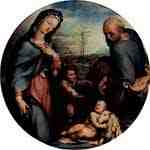
The Holy Family, Domenico Beccafumi

Venus and Cupid, Attributed to Heinrich Bollandt

Boy removes flees from his dog, Gerard ter Borch the Younger
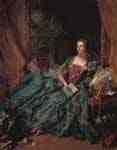
Portrait of Madame de Pompadour, François Boucher
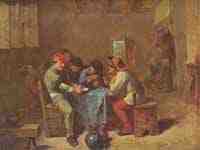
Card playing farmers in a tavern, Adriaen Brouwer
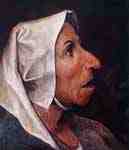
Old peasant woman, Pieter Bruegel the elder
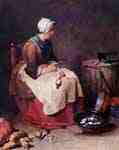
Woman peeling turnips, Jean-Baptiste Siméon Chardin
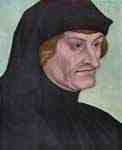
Portrait of Johannes Geiler von Kaiserberg, Lucas Cranach the elder
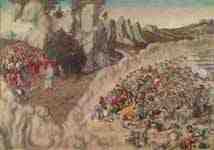
Downfall of Pharaoh in the Red Sea, Lucas Cranach the elder

Venus with Cupid, Lucas Cranach the younger

The Seven Sorrows of Mary : Our Lady of Sorrows , Albrecht Dürer
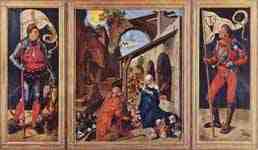
Paumgartner Altar , General View , Albrecht Dürer
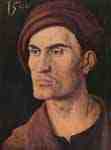
Portrait of a young man , Albrecht Dürer
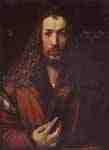
Self-portrait, Albrecht Dürer

Suicide of Lucretia, Albrecht Dürer

The Saints John and Peter, Albrecht Dürer

The Saints Mark and Paul, Albrecht Dürer
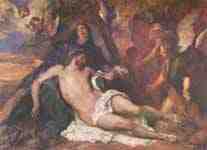
Lamentation of Christ, Anthony van Dyck
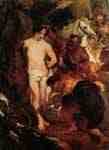
Martyrdom of Saint Sebastian, Anthony van Dyck
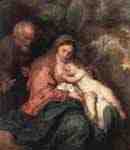
Rest on the Flight to Egypt, Anthony van Dyck
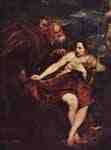
Susanna and the Elders, Anthony van Dyck
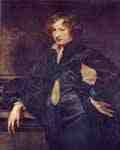
Self-portrait, Anthony van Dyck
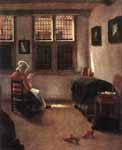
Reading Woman, Pieter Janssens Elinga
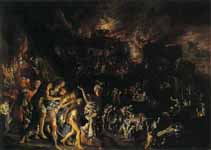
The Burning of Troy, Adam Elsheimer
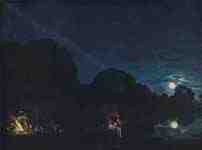
Flight to Egypt, Adam Elsheimer
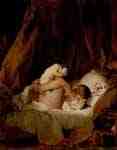
Girl in bed playing with a little dog, Jean-Honoré Fragonard
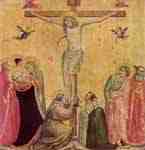
Christ on the cross between Mary and John, Giotto di Bondone
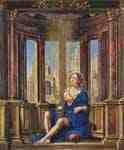
Danae, Jan Gossaert

The Disrobing of Christ, El Greco
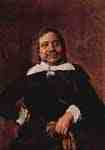
Portrait of a man with pointed collar, Frans Hals

Willem van Heythuyzen, Frans Hals
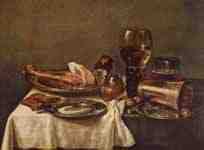
Still life with ham, Willem Claesz. Heda
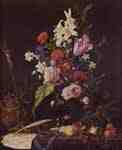
Bouquet of flowers in glass vase, Jan Davidsz de Heem
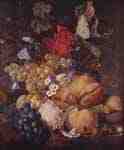
Fruits, flowers and insects, Jan van HuysumSatyr and the Peasant
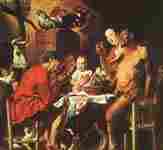
Satyr at the Peasant's House, Jacob Jordaens
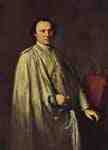
Portrait of Michael Gilbert, Moritz Kellerhoven
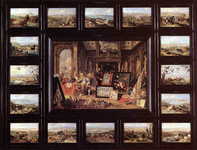
The Continent of Europe, Jan van Kessel the Elder
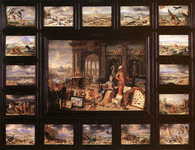
The Continent of Asia, Jan van Kessel the Elder
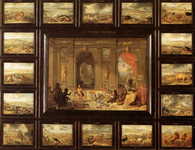
The Continent of Africa, Jan van Kessel the Elder
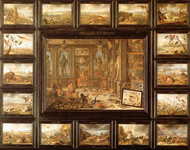
The Continent of America, Jan van Kessel the Elder

Madonna with the Carnation, Leonardo da Vinci
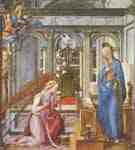
Annunciation to Mary, Fra Filippo Lippi

Nativity, Stefan Lochner
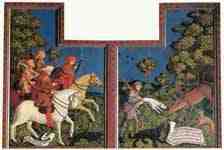
Duke Tassilo on horseback, accompanied by three squires, hunting, Master of the Pollinger panels
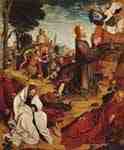
Passion series, scene: Christ on the Mount of Olives, Master of St. Severin

Portrait of Cardinal Charles of Bourbon, Master of Moulins

Scenes from the life of Mary, Hans Memling
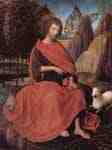
St. John the Baptist, Hans Memling

Children playing dice, Bartolomé Esteban Murillo
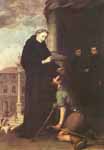
Thomas of Vilanueva heals the sick, Bartolomé Esteban Murillo
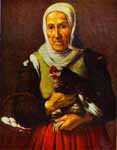
Old Woman with a Hen, Bartolomé Esteban Murillo

The Little Fruit-Seller, Bartolomé Esteban Murillo
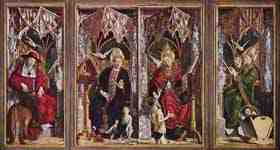
Fathers of the Church Altar, Overall View, Michael Pacher
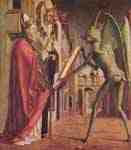
St. Augustine and the Devil, Michael Pacher
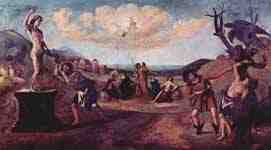
Myth of Prometheus, Piero di Cosimo

Vision of Saint Bernard, Pietro Perugino
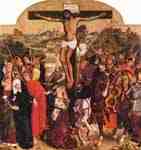
The Crucifixion , Hans Pleydenwurff
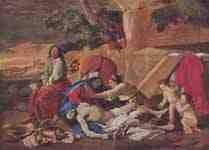
Lamentation of Christ, Nicolas Poussin
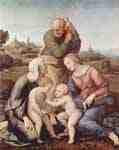
Sacra Familia Canigiani, Raphael
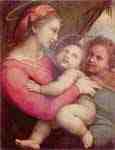
Madonna della Tenda, Raphael
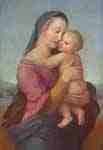
Madonna Tempi , Scene : Mary with Christ Child, Raphael
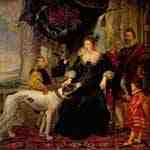
Alathea Talbot , Countess in Shrewsbury, Peter Paul Rubens
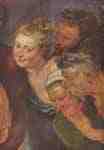
The drunken Silenus , detail, Peter Paul Rubens
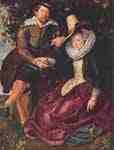
Self-portrait of the painter and his wife Isabella Brant , Peter Paul Rubens
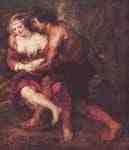
Shepherd scene, Peter Paul Rubens
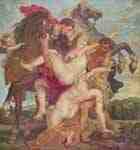
Rape of the Daughters of Leucippus, Peter Paul Rubens
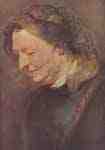
Portrait of an old woman, Peter Paul Rubens
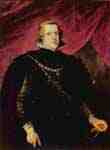
Portrait of Philip IV, Peter Paul Rubens
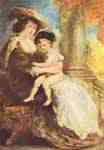
Hélène Fourment with her first-born son, Peter Paul Rubens

Portrait of Hélène Fourment in a wedding gown, Peter Paul Rubens
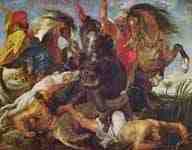
Hippopotamus hunt, Peter Paul Rubens

Defeat of Sennacherib, Peter Paul Rubens
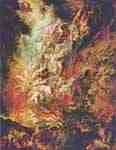
Hell of the Damned, Peter Paul Rubens
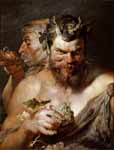
Two Satyrs, Peter Paul Rubens
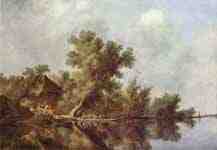
River Landscape with Ferry, Salomon van Ruisdael
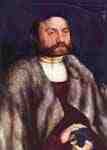
Hans Besserer I. of Schnürpflingen, Martin Schaffner

Adoration of the Magi, Giovanni Battista Tiepolo

The Pope Clement I prays to the Holy Trinity, Giovanni Battista Tiepolo

Volcano surprised Venus and Mars, Jacopo Tintoretto
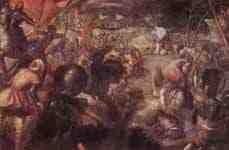
The Battle of the Taro, Jacopo Tintoretto
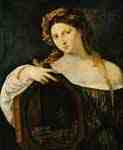
The vanity of earthly things ( Vanitas), Titian
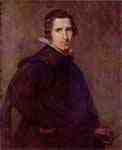
Portrait of a young Spaniard, Diego Velázquez

Peasants dancing, Januarius Zick
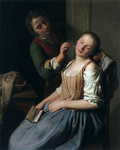
Sleeping Girl with Her Beau, Pietro Rotari
The Alte Pinakothek (Engl. Old Pinakothek) is an art museum situated in the Kunstareal in Munich, Germany.[1] It is one of the oldest galleries in the world and houses one of the most famous collections of Old Master paintings. The name (old Pinakothek) alludes to the time period covered by the art — the Neue Pinakothek covers 19th-century art and the recently opened Pinakothek der Moderne exhibits modern art, all galleries are part of Munich's "Kunstareal" (the "art area"). The museum is part of the Bavarian State Picture Collection (German: Bayerische Staatsgemäldesammlungen), an organization of the Free state of Bavaria.[2]
The building
King Ludwig I of Bavaria (1825–1848) ordered Leo von Klenze to erect a new building for the gallery for the Wittelsbach collection in 1826. The Alte Pinakothek was the largest museum in the world and structurally and conceptually well advanced through the use of skylights and the convenient accommodation of northern lights for the cabinets. Even the neo-renaissance exterior of the Pinakothek clearly stands out from the castle-like museum type usual in the early 19th Century. It is closely associated with the function and structure of the building as a museum. Very modern in its day, the building became exemplary for museum buildings in Germany and all of Europe after its inauguration in 1836, and thus became a model for new galleries in Rome, St Petersburg, Brussels and Kassel.
The museum galleries were designed to display Rubens's "Last Judgment" (1617), one of the largest canvasses ever painted. The museum building was severely damaged by bombing in World War II but was reconstructed and reopened to the public in the late 1950s. The ornate, pre-war interior including the large loggia facing the south façade in the upper floor were not restored. A new wall covering was created in 2008 for the rooms on the upper floor of the Alte Pinakothek with a woven and dyed silk from Lyon. The new color scheme of green and red draws on the design of the rooms, dates back to the time of construction of the Alte Pinakothek and was predominant until the 20th Century. Already for King Ludwig I and his architect Leo von Klenze the use of a wall covering alternately in red and green, showed the continuation of a tradition that dates back to the exhibition of the old masters of the late 16th Century in many of the major art galleries in Europe (Florence, London, Madrid, St. Petersburg, Paris, Vienna) and there exists to this day.
History
Alte Pinakothek, (hand-painted photograph, approx. 1890)
The Wittelsbach collection was begun by Duke Wilhelm IV (1508–1550) who ordered important contemporary painters to create several history paintings, including "The Battle of Alexander at Issus" of Albrecht Altdorfer. Elector Maximilian I (1597–1651) acquired paintings, especially the work of Albrecht Dürer. 21 paintings were confiscated and moved to Sweden during the occupation of Munich in the Thirty Years war. Maximilian's grandson Maximilian II Emanuel (1679–1726) purchased a large number of Dutch and Flemish paintings when he was Governor of the Spanish Netherlands. So he bought for example in 1698 in Antwerp from Gisbert van Colen 12 pictures of Peter Paul Rubens and 13 of Van Dyck, with the pictures of Rubens from the personal estate of the artist which were therefore not intended for sale. Under Max Emanuel's successors, the purchases were largely discontinued due to the tight budget.[3]
Also Max Emanuel's cousin Johann Wilhelm, Elector Palatine (1690–1716) collected Netherlandish paintings. He ordered from Peter Paul Rubens the "The Big Last Judgment" and received Raphael's "Canigiani Holy Family" as a dowry of his wife. Charles Theodore, Elector of Bavaria (1742-1799) had a strong preference for Netherlandish paintings as well, among other paintings he acquired Rembrandt's "The Holy Family". By the late 18th century a large number of the paintings were already displayed in Schleissheim Palace, and accessible to the public.
Room IX
.
After the reunion of Bavaria and the Electorate of the Palatinate in 1777, the galleries of Mannheim, Düsseldorf and Zweibrücken were moved to Munich, in part to protect the collections during the wars which followed the French revolution. Even though 72 paintings including "The Battle of Alexander at Issus" were taken to Paris in 1800 by the invading armies of Napoleon I (1769–1821),[4] who was a noted admirer of Alexander the Great. The Louvre held it until 1804, when Napoleon declared himself Emperor of France and took it for his own use. When the Prussians captured the Château de Saint-Cloud in 1814 as part of the War of the Sixth Coalition, they supposedly found the painting hanging in Napoleon's bathroom.[5] Most of the paintings have not been returned.
With the secularisation many paintings from churches and former monasteries entered into state hands. King Ludwig I of Bavaria collected especially Early German and Early Dutch paintings but also masterpieces of the Italian renaissance. In 1827 he acquired the collection Boisserée with 216 Old German and Old Dutch masters; in 1828, the king managed to also purchase the collection of the Prince Wallerstein, with 219 Upper German and Upper Swabian paintings. In 1838 Johann Georg von Dillis issued the first catalogue.
After the times of King Ludwig I the acquisitions almost ended, only from 1875 the directors Franz von Reber and Hugo von Tschudi secured some important new acquisitions, such as the "Madonna of the Carnation" of Leonardo da Vinci or "The Disrobing of Christ" of El Greco.
The predilection of the Wittelsbach rulers for some painters made the collection quite strong in those areas but neglected others. Since the 1960s the Pinakothek has filled some of these gaps: for example, a deficit of 18th-century paintings was addressed by the integration into the collection of works loaned from two Bavarian banks. Among others these paintings include Lancret's "The Bird Cage" and Boucher's "Madame Pompadour."
On 5 August 2014, the museum rejected a request by a descendant of the banker Carl Hagen for the repatriation of Jacob Ochtervelt's Das Zitronenscheibchen (The Lemon Slice) on the grounds that it had been unlawfully acquired as a result of Nazi persecution. An investigation by the museum established that it had been lawfully purchased at the time for a fair price and that the Hagen family's interest extended only to a security on the painting.[6]
Collection
"Kreuzigung Christi" (English: "Crucifixion of Christ") by Lucas Cranach the Elder
The museum is under supervision of the Bavarian State Picture Collection which own also an expanded collection of several thousand European paintings from the 13th to 18th century. Especially its collection of Early Italian, Old German, Old Dutch and Flemish paintings belongs to the most important in the world.
More than 800 of these paintings are exhibited in the Old Pinakothek. Due to limited space in the building some associated galleries throughout Bavaria such as the baroque galleries in Schleissheim Palace and Neuburg Palace display also the Old Masters. From 2014 through 2017, wings of the museum will be sequentially closed for renovation, and the artworks in closed sections will be unavailable for viewing.[7]
German paintings 14th–17th century:
The Alte Pinakothek comes with the most comprehensive collection of German Old Masters worldwide. Among many others the Pinakothek shows works of Stefan Lochner ("Adoration of the Christ Child by the Virgin (The Nativity)"), Albrecht Dürer ("The Four Apostles", "Paumgartner Altar", "Self-portrait in Fur Coat"), Hans Baldung Grien ("Margrave Christoph of Baden"), Albrecht Altdorfer ("The Battle of Issus"), Cranach ("Lamentation Beneath the Cross"), Holbein ("St. Sebastian Altar; Central panel: Martyrdom of St. Sebastian"), Matthias Grünewald ("SS. Erasmus und Maurice"), Michael Pacher ("Altar of the Church Fathers"), Hans von Aachen ("The Triumph of Truth"), Adam Elsheimer ("The Flight into Egypt"), Johann Liss ("Death of Cleopatra").
Early Netherlandish paintings 15th–16th century:
One of the most impressive collections worldwide especially for Early Netherlandish paintings with masterpieces for example of Rogier van der Weyden ("Columba Altar"), Dieric Bouts ("Ecce Agnus Dei"), Lucas van Leyden ("Virgin and Child with Mary Magdalen and a Donor"), Hieronymus Bosch ("Fragment from the Last Judgment"), Hans Memling ("The seven joys of the virgin"), Jan Gossaert, aka. Mabuse ("Danae").
Dutch paintings 17th–18th century:
Due to the passion of the Wittelsbach rulers this section contains numerous exquisite paintings. Among the masters are Rembrandt van Rijn ("The Deposition", "The Holy Family"), Frans Hals ("Portrait of Willem Croes"), Pieter Lastman ("Odysseus and Nausikaa"), Carel Fabritius ("Self-Portrait"), Gerard Terborch ("The Flea-Catcher (Boy with His Dog)"), Jacob van Ruisdael ("Torrent with Oak Trees") and many others.
Flemish paintings 16th–18th century:
The collection contains masterpieces of painters like Jan Mabuse ("Danae"), Pieter Brueghel the Elder ("Harbour Scene with Christ Preaching", "The Land of Cockaigne"), Hans Memling ("The Seven Joys of the Virgin" ), Jan Brueghel the Elder ("Harbour Scene with Christ Preaching"), Peter Paul Rubens ("Rubens and Isabella Brant in the Honeysuckle Bower") ("The Fall of the Damned") ("The Big Last Judgment"), van Dyck ("Self-Portrait", "Susanna and the Elders"), Jacob Jordaens ("Satyr with Peasants") and Adriaen Brouwer ("Village Barbar's Shop"). The Rubens Collection is the largest one worldwide.
Leonardo da Vinci's "Virgin and Child (Madonna of the Carnation)"
Italian paintings 13th–18th century:
The Italian Gothic paintings are the oldest of the gallery, among them Giotto's famous "The Last Supper", then all Schools of Italian Renaissance and Baroque Painting are represented with works of Fra Angelico ("Entombment of Christ"), Domenico Ghirlandaio ("Virgin and Child with SS. Dominici, Michael, John the Baptist and John the Evangelist"), Sandro Botticelli ("Lamentation of Christ"), Fra Filippo Lippi ("The Annunciation"), Lorenzo Lotto ("The Mystic Marriage of St. Catherine"), Raphael ("The Canigiani Holy Family") ("Madonna della tenda"), ("Madonna Tempi"), Leonardo da Vinci ("Madonna of the Carnation"), Antonello da Messina ("Annunciata"), Titian ("Vanity") ("Charles V"), Tintoretto ("Christ in the House of Mary and Martha"), Guido Reni ("The Assumption of the Virgin"), Luca Giordano ("A cynical philosopher"), Tiepolo ("The Adoration of the Kings"), Francesco Guardi ("Regatta on the Canale della Guidecca"), Canaletto ("Piazetta in Venice") and others.
French paintings 16th–18th century:
In spite of the close relationship of the Wittelsbach to France it is the second smallest section with works for example of Claude Lorrain ("The Expulsion of Hagar"), Nicolas Poussin ("Midas and Bacchus"), François Boucher ("Madame de Pompadour") ("Reclining Girl"), Nicolas Lancret ("The Bird Cage"), Jean-Baptiste-Siméon Chardin ("Woman Cleaning Turnips"), Maurice-Quentin de la Tour ("Mademoiselle Ferrand Meditating on Newton"), Claude Joseph Vernet ("Eastern Harbour at Dawn") and Jean-Honoré Fragonard ("Girl with Dog").
Spanish paintings 16th–18th century:
Though this is the smallest section all major masters are represented, such as El Greco ("The Disrobing of Christ"), de la Cruz ("Infant Isabella Clara Eugenia of Spain"), Velázquez ("Young Spanish Gentleman"), Jusepe de Ribera ("Saint Bartholomew"), Zurbarán ("The Entombment of St. Catharine of Alexandria on Mount Sinai") and Murillo ("Beggar Boys Eating Grapes and Melon"). The paintings of Francisco de Goya were moved into the New Pinakothek.
References
Alte Pinakothek. Summary Catalogue. Edition Lipp, 1986. ISBN 3-87490-701-5.
Wood, Christopher S. (1993). Albrecht Altdorfer and the Origins of Landscape. Reaktion Books. ISBN 0-948462-46-9.
External links
Wikimedia Commons has media related to Alte Pinakothek.
Official website (in English)
Panorama Alte Pinakothek
Notes
"Alte Pinakothek". http://www.pinakothek.de. Retrieved 6 August 2014.
"The Pinakothek". Trip advisor. Retrieved 19 July 2014.
"ALTE PINAKOTHEK REVIEW". Fodor's. Retrieved 19 July 2014.
Alte Pinakothek, pp. 24–29
Wood, p. 22
"Alte Pinakothek rejects restitution claim for Das Zitronenscheibchen' by Jacob Ochtervelt". codart.nl.
http://www.pinakothek.de/en/renovation-alte-pinakothek
----
Fine Art Prints | Greeting Cards | Phone Cases | Lifestyle | Face Masks | Men's , Women' Apparel | Home Decor | jigsaw puzzles | Notebooks | Tapestries | ...
----
Artist
A - B - C - D - E - F - G - H - I - J - K - L - M -
N - O - P - Q - R - S - T - U - V - W - X - Y - Z
Retrieved from "http://en.wikipedia.org/"
All text is available under the terms of the GNU Free Documentation License


